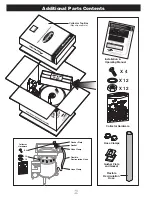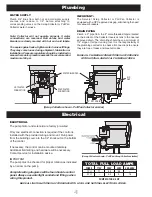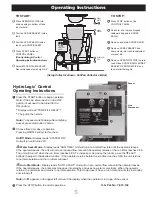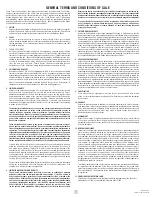
6
Troubleshooting
How it works
WARNING! DISCONNECT THE POWER TO THE SYSTEM BEFORE SERVICING.
This troubleshooting guide is to provide basic checks to facilitate problem isolation and repair.
All repairs should be made according to local codes and by a qualified technician.
IMPORTANT!
Do NOT use corrosive chemicals for scrapping or cleaning purposes!
PROBLEM
POSSIBLE CAUSE
SOLUTION
Collector will not turn on.
Tank will not fill up.
Only cold or hot water is
going into tank.
Pump motor not
running.
Water leaks from pump.
Water plume is very low
or Collector is not
pumping water.
Sensor does not detect
operator leaving work
area.
Tripped breaker.
Disconnect in off position.
Blown fuses on transformer.
Drain open.
Valves are closed.
Hot or cold valve closed.
Blender is out of adjustment.
Water connections reversed.
Overload tripped.
Contactor not energized.
Pump seal/o-ring broken.
Clamps loose.
Clogged pump.
Clogged pump intake screen.
Water plume valve turned down.
Pump motor running backwards.
Object blocking sensor.
Water Saver or Auto Start not turned on.
Dirty sensor.
Reset breaker.
Turn to ON position.
Replace blown fuse(s).
Install overflow pipe.
Open valves.
Open valves.
Adjust setting of blender.
Correct water connections.
Wait for overload to reset and check for cause of
reset to trip, i.e. debris in pump.
Check contactor connections.
Replace seal/o-ring.
Tighten clamps
Open pump and remove debris.
Clean screen.
Adjust water plume valve until plume is approximately 6”.
Reverse rotation of pump.
Remove object from in front of sensor.
Turn on Water Saver or Auto Start.
Clean sensor.
• Warm water enters the tank and the Collector pump
recirculates water through the recirculation hose.
• As dishes are passed through the water plume, they are
scrapped and pre-rinsed at the same time. Soluble
food waste washes through the holes in the scrap basket
and into the tank reservoir.
• Insoluble and fibrous food waste is retained in the scrap
basket for disposal.








